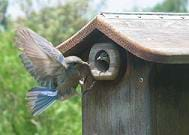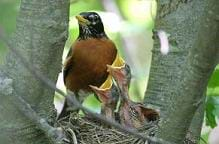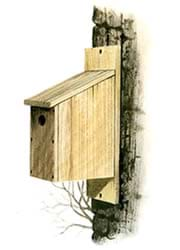Quick Look
Grade Level: 4 (3-5)
Time Required: 1 hours 15 minutes
80 minutes (2 class periods) for the house and nest. The research component can be as long and extensive as the teacher wishes.
Expendable Cost/Group: US $5.00 Some non-expendable tools are needed for this activity; see the Materials List for details.
Group Size: 3
Activity Dependency: None
Subject Areas: Measurement, Science and Technology
NGSS Performance Expectations:

| 3-5-ETS1-1 |

Summary
Students construct bird nests and birdhouses. They research birds of their choosing and then design houses that meet the birds' specific needs. It works well to conduct this activity in conjunction with a grades 9-12 woodshop class by partnering the older students with the younger students (but it is not required to do this in order to conduct the activity).Engineering Connection
Building birdhouses can be an involved activity that includes many steps of the engineering process, such as designing a prototype, and deciding what materials and tools to use. While learning these steps, students become familiar with ways that engineering expertise and approaches can be applied to natural systems.
Learning Objectives
After this activity, students should be able to:
- Describe properties of materials used and why they are good for building a house.
- Understand the use of materials, wood and nails or glue, and a tool, the hammer.
- Explain the relationship between materials and tools.
- Understand birds need shelter for protection from weather and predators, and to safely hatch eggs.
- Learn that different birds require different sized houses.
Educational Standards
Each TeachEngineering lesson or activity is correlated to one or more K-12 science,
technology, engineering or math (STEM) educational standards.
All 100,000+ K-12 STEM standards covered in TeachEngineering are collected, maintained and packaged by the Achievement Standards Network (ASN),
a project of D2L (www.achievementstandards.org).
In the ASN, standards are hierarchically structured: first by source; e.g., by state; within source by type; e.g., science or mathematics;
within type by subtype, then by grade, etc.
Each TeachEngineering lesson or activity is correlated to one or more K-12 science, technology, engineering or math (STEM) educational standards.
All 100,000+ K-12 STEM standards covered in TeachEngineering are collected, maintained and packaged by the Achievement Standards Network (ASN), a project of D2L (www.achievementstandards.org).
In the ASN, standards are hierarchically structured: first by source; e.g., by state; within source by type; e.g., science or mathematics; within type by subtype, then by grade, etc.
NGSS: Next Generation Science Standards - Science
| NGSS Performance Expectation | ||
|---|---|---|
|
3-5-ETS1-1. Define a simple design problem reflecting a need or a want that includes specified criteria for success and constraints on materials, time, or cost. (Grades 3 - 5) Do you agree with this alignment? |
||
| Click to view other curriculum aligned to this Performance Expectation | ||
| This activity focuses on the following Three Dimensional Learning aspects of NGSS: | ||
| Science & Engineering Practices | Disciplinary Core Ideas | Crosscutting Concepts |
| Define a simple design problem that can be solved through the development of an object, tool, process, or system and includes several criteria for success and constraints on materials, time, or cost. Alignment agreement: | Possible solutions to a problem are limited by available materials and resources (constraints). The success of a designed solution is determined by considering the desired features of a solution (criteria). Different proposals for solutions can be compared on the basis of how well each one meets the specified criteria for success or how well each takes the constraints into account. Alignment agreement: | |
Common Core State Standards - Math
-
Use appropriate tools strategically.
(Grades
K -
12)
More Details
Do you agree with this alignment?
International Technology and Engineering Educators Association - Technology
-
Select and safely use tools, products, and systems for specific tasks.
(Grades
3 -
5)
More Details
Do you agree with this alignment?
-
Identify the resources needed to get a technical job done, such as people, materials, capital, tools, machines, energy, and time.
(Grades
3 -
5)
More Details
Do you agree with this alignment?
-
Illustrate that there are multiple approaches to design.
(Grades
3 -
5)
More Details
Do you agree with this alignment?
-
Follow directions to complete a technological task.
(Grades
3 -
5)
More Details
Do you agree with this alignment?
-
Design solutions by safely using tools, materials, and skills.
(Grades
3 -
5)
More Details
Do you agree with this alignment?
-
Evaluate designs based on criteria, constraints, and standards.
(Grades
3 -
5)
More Details
Do you agree with this alignment?
State Standards
Massachusetts - Math
-
Use appropriate tools strategically.
(Grades
Pre-K -
12)
More Details
Do you agree with this alignment?
Massachusetts - Science
-
Identify and explain the appropriate materials and tools (e.g., hammer, screwdriver, pliers, tape measure, screws, nails, and other mechanical fasteners) to construct a given prototype safely.
(Grades
3 -
5)
More Details
Do you agree with this alignment?
-
Identify a problem that reflects the need for shelter, storage, or convenience.
(Grades
3 -
5)
More Details
Do you agree with this alignment?
-
Identify relevant design features (e.g., size, shape, weight) for building a prototype of a solution to a given problem.
(Grades
3 -
5)
More Details
Do you agree with this alignment?
Materials List
For the birdhouse:
- wood (see the procedure section for specifications on the wood pieces needed)
- nails (length 1.5 times the wood depth)
- hammer
- screwdriver
- wood screws (length 1.5 times the wood depth)
For the nest:
- paper plates (9-in [22.9-cm] diameter or less)
- grass/hay
- leaves
- small twigs
- bits of plastic (birds often use human made materials to build their nests)
- 3 plastic drinking straws
- 6 ft string
- scissors
- model or picture of nest to show
Worksheets and Attachments
Visit [www.teachengineering.org/activities/view/wpi_birdhouse_act_joy] to print or download.Introduction/Motivation

When most people think of bird's nests, they imagine bundles of sticks nestled between tree branches, and held together with mud – a nest such as that made by robins (see Figure 2).
Some birds however, such as the blue bird or chickadee, nest in tree cavities (holes in decayed tree trucks). As forests are cleared for human developments, habitats such as mature forests with decayed trees are destroyed, reducing essential habitat for cavity-nesting birds.

To help preserve or improve bird populations, people have been building and putting up nest boxes (see Figures 1 and 3). Nest box programs have been successful in increasing populations of many cavity-nesting birds such as bluebirds.
Today, you will be designing and building your own birdhouse using limited materials and time.
Procedure
Preparation:
For the birdhouse option:
A birdhouse built to the following proportions is intended to attract chickadees. Dimensions will vary a bit, depending on wood thickness and bird type (see References). You may want to investigate specifications that would benefit the wildlife in your region.
(optional idea) It works well to arrange a group effort with another teacher's grade 9-12 woodshop students. The older students can measure and cut the wood (in advance ) and partner with the younger students to watch over them nailing the birdhouses together. If that is not possible, obtain appropriately sized wood and glue. Hardware and lumber retailers often donate wood scraps to schools.
Cut the following wood pieces (refer to the attached Nest Box Diagram):
- Front: 6 x 4 x 1 in (15.3 x 10 x 2.5 cm) with hole 1.25 in (3.2 cm) in diameter centered 3 in (7.6 cm) above bottom
- Back: 6 x 4 x 1 in (15.3 x 10 x 2.5 cm)
- Top and Bottom: 4 x 4 x 1 in (10 x 10 x 2.5 cm)
- Side: 6 x 6 x 1 in (15.3 x 15.3 x 2.5 cm)
For the nest option:
As homework or during recess, have students collect natural materials from an area in their neighborhoods where birds are found. In rural areas this might be their backyards; in more urban areas this may be a park, or along the street. Tell students that collecting small pieces of trash is appropriate to the mix; birds use what is available.
With the Students:
Teach students about bird habitats and shelters.
Introduce students to tools and materials (wood, hammer, nails, screws, screwdriver, tape measure), and discuss the difference between tools and materials. As necessary, review pertinent safety precautions and tool skills.
For the birdhouse:
- Have the (woodshop) teacher give a demonstration of and instructions for the birdhouse construction.
- Divide the class into groups of two to four students.
- Hand out already-cut wood pieces to the teams.
- With a woodshop student assisting each group, have the young students nail together their birdhouses.
For the nest:
- Brainstorm and discuss what types of objects birds might use to build their nests.
- Looking at the model and picture of actual nests, create your own birds nests using a paper plate as a base.
Birdhouse design:
After students have constructed the birdhouses and built their nests, have them research birds of interest and design shelters that meet a particular bird's needs.
Vocabulary/Definitions
material: What things are made of (for example. a nail is a material when it is part of a birdhouse, but can be used as a tool to poke holes in things).
tool: A device used to help accomplish a specific task.
Assessment
Evaluation: Use the following guide to grade students, assuming they did all three items: nest, worksheet and birdhouse.
- 3 products completed, excellent effort = A
- 2 products completed, good effort = B
- 1 product completed, minimal effort = C
- 0 completed, no effort = F
Quiz: As an alternative post-activity assessment, ask students to write descriptions of which tools were used for which tasks in creating the nests and birdhouses.
Investigating Questions
- Why do birds need shelter?
- Compare and contrast the nest and the birdhouse.
- What materials did we use in constructing the birdhouses and nests?
- What tools did we use in constructing the birdhouses and nests?
- What safety precautions should you use when using these materials?
Activity Extensions
Have students design their own birdhouses or come up with ideas to improve the current birdhouse designs.
Subscribe
Get the inside scoop on all things TeachEngineering such as new site features, curriculum updates, video releases, and more by signing up for our newsletter!More Curriculum Like This

Students use the engineering design process to design innovative human shelters that are inspired and informed by animal structures. Each group is assigned an animal class, and then they gather information about shelters used by the animals in that class.
References
Build an Oriole Nest. Journey North. The construction of an Oriole's nest from the bird's perspective. http://www.learner.org/jnorth/tm/oriole/BuildNest.html
Mayntz, Melissa. Before you Build a Birdhouse Birdhouses can be as easy or as difficult to build as you want, and there are birdhouse plans available for many different styles. How do you choose the best one for your backyard birds? About.com. http://birding.about.com/od/birdhouses/bb/beforebuild.htm
Collier, Julia. "A Builder, a Collector, a Scratcher, and a Thief." Spring/Summer 97 and Fall/Winter 97. DVRC Journals, Delaware Valley Raptor Center Nesting habits of birds of prey http://www.dvrconline.org/builder.html
Nest Watch. Nest box cams of several species. Cornell Lab of Ornithology Bird House Network Nest Box Cams http://www.birds.cornell.edu/birdhouse2/nestboxcam/
Copyright
© 2005 by Regents of the University of Colorado; original © 2005 Worcester Polytechnic InstituteSupporting Program
K-12 Outreach Office, Worcester Polytechnic InstituteLast modified: September 29, 2021







User Comments & Tips